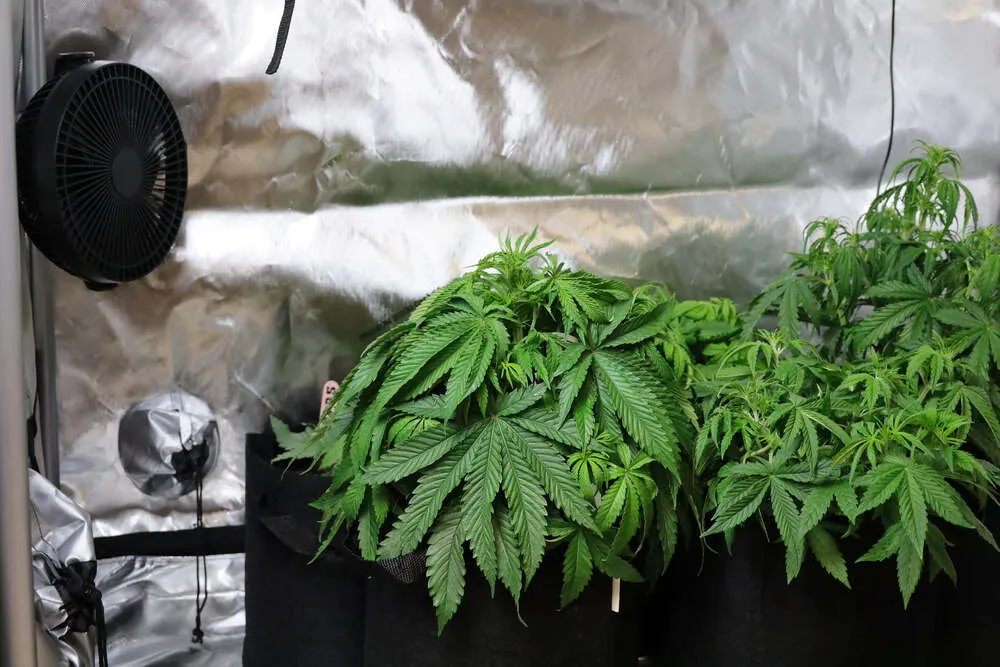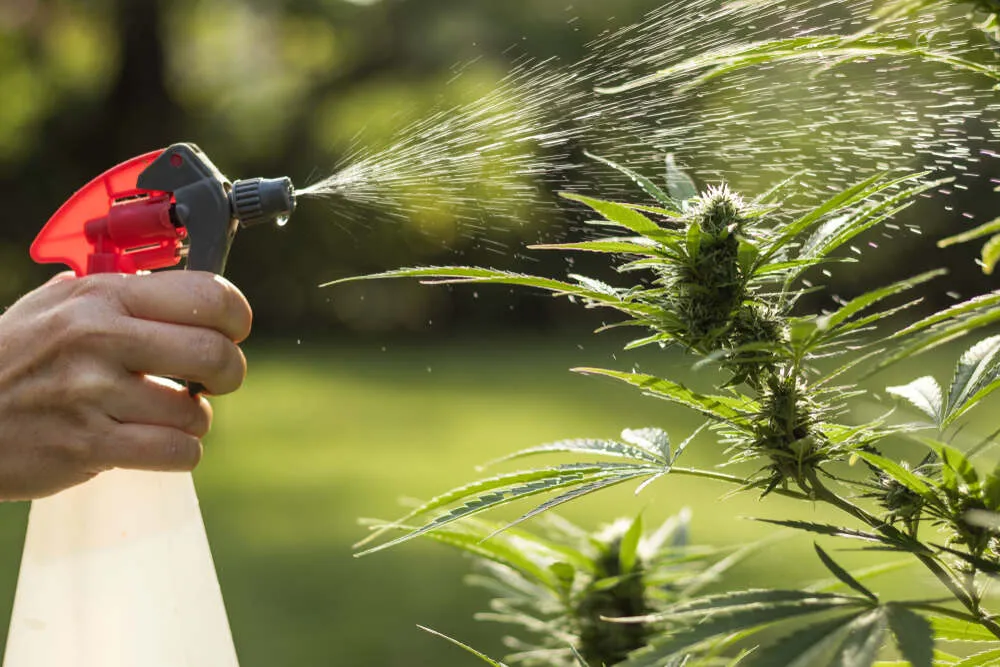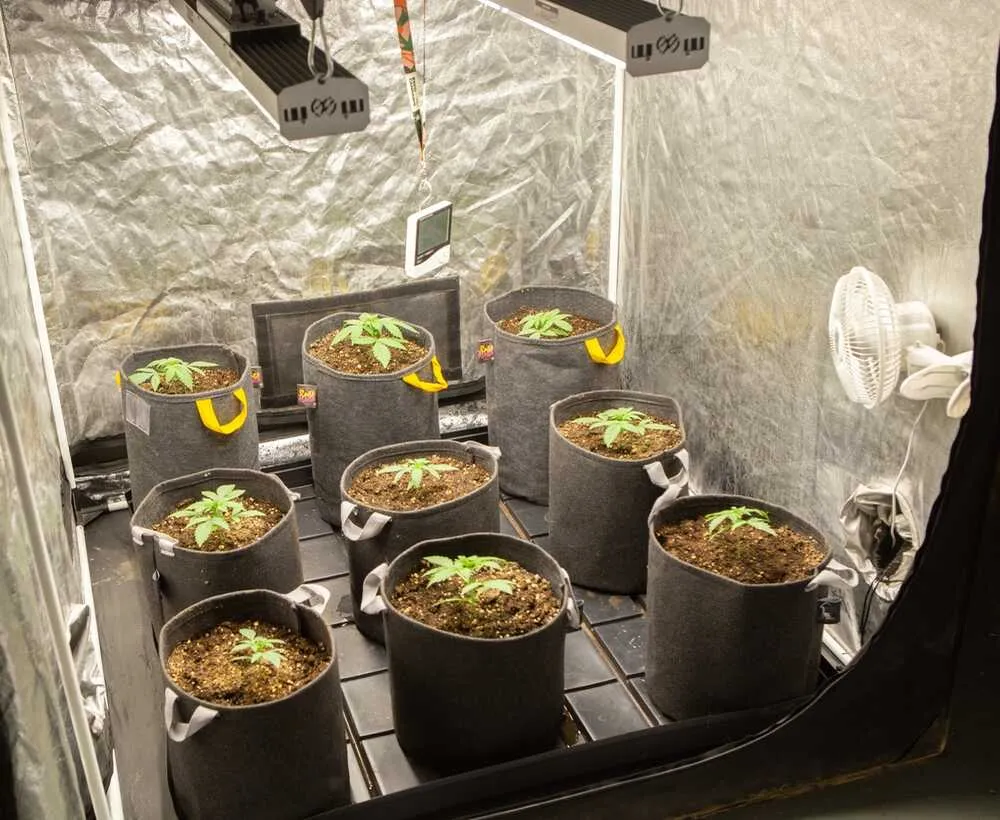Identify and treat powdery mildew on cannabis

One of the easier-to-diagnose and treat plant issues is Powdery Mildew, also known as White Powdery Mildew, White Powdery Mold, or even just WPM. It's a real bummer to find, no doubt, but a relatively easy fix—as long as you identify it early and treat it quickly.
But what is Powdery Mildew exactly? Why does it love weed plants as much as we do? What's the best way to identify, treat, and prevent it from spreading, or even stop it from hitting your next crop at all?
What is powdery mildew on cannabis?
Powdery Mildew is a fungal disease caused by the pathogen Podosphaera Xanthii. It's also referred to as Oidiopsis Taurica, but they both are different species of the same pathogen. The fungus grows on the surface of plants, forming fuzzy white patches that resemble a powdery coating, or little patches of cooking flour, hence its name.
How powdery mildew forms on cannabis plants
There are really only two things that Powdery Mildew likes to do. Reproduce (by producing spores) and eat your plants, with cannabis being the equivalent of a Michelin-starred meal for it.
The fungus feeds on the plant's nutrients and moisture, which weakens the leaves and can eventually cause them to die off. If left untreated, it can spread rapidly throughout the plant, affecting flowers, stems, and even roots.
Why cannabis plants are susceptible to powdery mildew
Most types of fungus love warm, damp environments, and Powdery Mildew is no exception. Indoor cannabis grows check off both of those boxes, making it an ideal breeding ground for this pesky fungus.
But even outdoor grows are not immune to Powdery Mildew. If you are growing in an area with high heat and humidity or just experiencing a little more rain than usual, then the chance of your plants developing Powdery Mildew jumps up pretty quickly.
Causes of powdery mildew on cannabis

As mentioned, heat and humidity are the main environmental factors contributing to Powdery Mildew growth. But what are the growing practices that help create an environment with high heat and humidity?
- Poor air circulation: If your plants don't have enough space between them or aren't getting enough fresh air, it creates an environment that is extremely conducive to Powdery Mildew growth.
- Reduced ventilation: On top of having enough air circulation within your grow space, you also need proper ventilation to push out the old, stale air and bring in fresh air. Without this exchange, your plants are at a higher risk of developing Powdery Mildew.
- Overly wet growing media: Overwatering or using soil that holds onto moisture for too long can also create a damp environment that's perfect for Powdery Mildew.
- Crowded growing area: When plants are too close together, they create a microclimate that Powdery Mildew really loves. When the plants are touching, the chances of the fungus spreading increases.
- Temperature changes: When the temperature fluctuates drastically, it creates an ideal environment for the fungus to thrive. This is why Powder Mildew is more common in the late summer/fall when temperatures drop and humidity rises - just in time for harvest, great!
How to identify powdery mildew on cannabis plants
Unlike many of the common issues that can plague cannabis plants and can moonlight as each other, Powdery Mildew stands alone and is relatively easy to identify. The telltale signs are the white, powdery patches that appear on leaves and other parts of the plant.
Early signs and symptoms of powdery mildew
At first, Powdery Mildew may look like a light dusting of flour or baby powder on your plants. Before the patches fully form, it's more of a very sparse white growth that looks akin to tiny spider webs. It also tends to start on the tops of leaves but can quickly spread to the underside as well.
Visual indicators: what powdery mildew looks like on cannabis leaves
Once it really gets going, it's pretty unmistakable. The white patches will become denser and tightly packed, while also spreading to the point where the entire leaf may eventually be covered.
You may also see the affected area yellowing or browning as the fungus continues to feed on the plant, slowly killing the areas it's attached to.
How to treat powdery mildew on cannabis

A quick Google search will show page after page of businesses trying to sell their "super-duper" cure for Powdery Mildew. But the reality is that you probably have everything you need at home right now.
Organic treatments for powdery mildew (Neem oil, milk sprays, etc.)
Neem oil will probably work, but it is slightly overkill for Powdery Mildew - I can’t say a definite yes or no as I haven't needed to try it.
Surprisingly, milk is your best option. The fat content of milk creates a layer on the leaves that prevents the spores from attaching and growing.
To use, mix 1 part of cow's milk (whole or skimmed) with 3 parts of water in a spray bottle and apply directly to the affected areas. Repeat every few days until the white patches disappear.
Chemical treatments for powdery mildew (fungicides)
Can you use fungicides to treat Powdery Mildew? Yes. Should you use them? Probably not, but if the mold has really set in, then you can consider it, for sure.
If Neem oil is overkill, then a full-on synthetic fungicide (which is designed to kill the fungus on contact) is all-out war.
While it will get rid of the problem in the short term, it can also damage your plants and potentially reduce your yield, and the last thing you want to be doing is smoking anything with traces of fungicide on it.
The best course of action
I got a little complacent with my most recent outdoor grow (I live in the tropics, and we had a particularly wet few weeks, during which I was not vigilant enough), and I let Powdery Mildew get a solid hold on two of my plants.
I hadn't had to deal with it for about a decade, but during my first few years growing, I learned a few things that thankfully stuck with me. There are just five simple steps to follow:
- Remove the affected fan leaves: If it's only a few leaves, you can pinch them off with your fingers (be sure to wash your hands well after). If there is widespread infection, then trim and dispose of the entire affected area. You can also use a wet paper towel to rub off the white patches but be gentle as you don't want to damage the leaves further or spread the spores.
- Use milk spray: As mentioned earlier, mix 1 part cow's milk with 3 parts water in a spray bottle and apply directly to the affected areas. You can use this pretty liberally and make sure to wet both sides of the leaves.
- Increase air circulation: Set up at least one oscillating fan inside the grow area, to help keep the air moving and prevent stagnant pockets where humidity can build up. Make sure your extraction fan is also doing its job.
- Monitor humidity: Invest in a hygrometer to monitor the humidity levels inside your grow space. If it's consistently above 50%, then you may need to invest in a dehumidifier or other measures to lower it.
- Remove any affected buds: This one is hard, but if you see any buds with Powdery Mildew on them, they need to go. It's better to lose a few than risk contaminating your entire harvest.
You may need to spray and scrub/remove affected areas a few times before the Powdery Mildew is completely eradicated.
Preventing powdery mildew in future cannabis grows

Growing great ganga is all about learning from mistakes. Now that you've dealt with and (hopefully) eradicated Powdery Mildew from your current grow, here are some tips to prevent it in the future.
Best practices for airflow and humidity control
Airflow, both inside your grow space and in/out of it, is crucial in preventing Powdery Mildew. Make sure you have adequate ventilation and fans to keep the air moving.
If growing indoors, invest in a dehumidifier to keep humidity levels down if needed, as well as a hygrometer to monitor them.
The role of regular pruning and plant spacing
Regular pruning can help with airflow and prevent Powdery Mildew. Removing any dead or dying leaves, as well as trimming excess foliage to allow for better air circulation, can go a long way in reducing the chances of infection.
Proper plant spacing is also important - if plants are crowded together, it's easier for spores to spread between them, and much more likely that the heat and humidity will rise to unsafe levels.
Keep your grow space clean and sanitize regularly for best results.
Preventive sprays and fungicides for ongoing mildew control
I don't use any preventive sprays, but if you're concerned about future outbreaks or have a history of recurring Powdery Mildew, there are some organic options available for ongoing control.
Sulfur-based fungicides, potassium bicarbonate, and baking soda are all commonly used in the cannabis industry to prevent mildew growth. As always, do your research and use caution when introducing any chemicals or substances into your grow space.
How powdery mildew affects cannabis yield and quality
The impact of mildew on cannabis bud quality
You shouldn't smoke, vape, cook with, or extract from bud that has Powdery Mildew - simple.
Not only can it cause respiratory issues, but it also affects the taste and overall quality of your bud. The fungus changes the chemical composition of the plant, resulting in a bitter and harsh smoke, and a pretty horrible aftertaste.
FAQs:
Can powdery mildew on cannabis spread to other plants?
Yep, PM loves pretty much any and all plant material. Just make sure to quarantine and treat any plants that show signs of infection and take extra precautions in the future to prevent cross-contamination.
Is powdery mildew harmful to humans?
Yes, but only mildly. If you have a compromised immune system, inhaling spores or consuming infected plant material can cause respiratory issues and other health problems. It's best to avoid any contact with Powdery Mildew.
Can you smoke cannabis with powdery mildew?
If you want, I'm not your mother. But as mentioned earlier, smoking or consuming bud with Powdery Mildew is not recommended and can be a rough old time for your body. Plus, it tastes like crap.
-
20+ Years Experience
Over 500K seeds sold worldwide
100K+ Happy Customers -
Germination Guaranteed
Complete satisfaction or we will replace your order -
Dutch and USA Genetics
Master breeders inspiring strains from across the world -
1-5 Day Delivery - Guaranteed
Free Express Shipping to the US, Canada and UK








